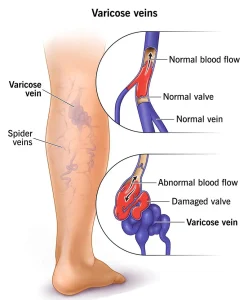Overview
Diagnosis
To diagnose varicose veins, a healthcare professional performs a physical examination. This includes checking your legs while you are standing to observe any swelling or visible vein changes. You may also be asked to describe symptoms such as pain, aching, or heaviness in your legs.
Tests
A venous Doppler ultrasound of the leg is often used to confirm the diagnosis. This painless test uses sound waves to evaluate blood flow through the veins and check how well the valves are functioning. It can also detect the presence of any blood clots.
Treatment
Treatment for varicose veins depends on the severity of the condition and your symptoms. Options may include self-care measures, compression stockings, or medical procedures. Most treatments are outpatient, meaning you can return home the same day.
Before proceeding, check with your insurance provider. If the treatment is cosmetic and done solely to improve the appearance of your legs, it may not be covered by insurance.
Self-care
Simple lifestyle changes can help relieve pain and prevent varicose veins from worsening:
-
Engage in regular exercise to improve circulation
-
Elevate your legs when sitting or lying down
-
Wear compression stockings as recommended
These measures can reduce discomfort and slow disease progression.
Compression stockings
Compression stockings are often the first treatment approach. They gently squeeze your legs, helping veins and muscles move blood more efficiently. The level of compression varies by type and brand.
You can buy them at pharmacies and medical supply stores, or your healthcare provider can prescribe a stronger version if your symptoms are significant. In some cases, insurance may cover prescription-strength stockings.
Surgeries or other procedures
If self-care and compression stockings are not effective, your healthcare professional may recommend one of several minimally invasive or surgical options:
-
Sclerotherapy: A healthcare professional injects a solution or foam into the varicose veins, causing them to scar and close. Over time, the treated veins fade. Some veins may require multiple sessions. The procedure is done in an office setting and doesn’t require anesthesia.
-
Laser treatment: Strong bursts of light are directed at the varicose vein, causing it to fade and disappear without the need for cuts or needles.
-
Catheter-based procedures using radiofrequency or laser energy: Used for larger veins, this method involves inserting a thin tube (catheter) into the vein. Heat from radiofrequency or laser energy collapses and seals the vein.
-
High ligation and vein stripping: In this outpatient procedure, a varicose vein is tied off before it joins a deeper vein and then removed through small incisions. Removing the vein doesn’t harm circulation because deeper veins handle most blood flow.
-
Ambulatory phlebectomy: Smaller varicose veins are removed through tiny punctures in the skin. The area is numbed, and the procedure typically leaves little to no scarring.
These treatments are effective in reducing symptoms, improving leg appearance, and preventing complications associated with varicose veins.
Advertisement

